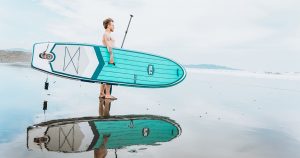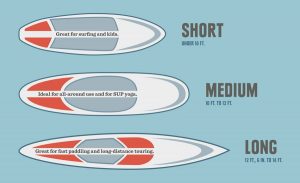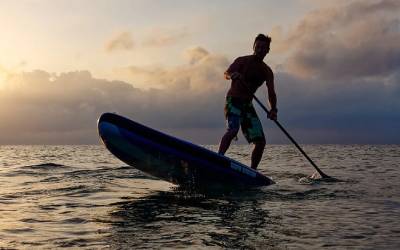SUPs come in multiple shapes and sizes. There are brands that offer wider SUPs, and then some brands provide slimmer SUPs. Some boards are lighter than others, and some are more durable. Then there is a difference in materials as well. In short, there are multiple factors that you must keep in mind while buying the board as they help you in choosing wisely. In this article, we will be covering all the essential factors that you must keep in mind while selecting the board for you.

How to buy an Inflatable Board?
- What is your use? – Boards have several uses. You can use them to surf on waves. They can be used to paddle on stable waters like lakes and choppy waters like rivers and oceans. Different boards will serve different usages.
- Your Ability and skill – If you are just starting then you will need a thicker and wider boards as they are more stable, but with increase in experience you can trade off some stability for other aspects like speed.
- Can you store it? – While buying th board you must also look at if you can safely and securely transport it to the beach or wherever you are planning to paddle. You must also be ready to sacrifice some storage space for the board.
- What is your Budget? – SUPs come in a variety of price ranges. You can spend $250 but the quality will be according to the price. Generally uou can get an over-all decent board at around $500. But you can always go upwards in price for better performance and qualities.

Considerations:
- Length – The iSUP length primarily determines as to how fast the SUP is and how its handling is. The shorter the board, the easier it is to turn, but that also means that the speed will decrease and it will become challenging to keep the board in a straight line. Following is the size bifurcation as peruse:
- Smaller than 10’ – Shorter boards are ideal for kids to learn to paddle as they are easy to turn. This ability also makes them suitable for surfing.
- 10’-12’ Long – This is the typical sizing which makes these lengths of boards, all-rounders. It does not matter if you are a beginner or an intermediate paddler; these boards will work with you.
- Longer than 12’ – These boards are generally for ‘touring’ and are fast. They are stable and can glide in a straight line. But the length also makes them less maneuverable.
- Width – iSUPs come with width ranging from 29” to 36”. The wider the board is, the more stable it gets, but that eats up on the manoeuvrability of the board. 30”-33” are the most commonly available board out there.
- Thickness – The last dimension based criteria is the thickness of the board. Most boards are 6” thick and provide enough performance. Although there are options with lesser thickness, they don’t have a high load-carrying capacity and also run at higher prices. This is why most paddlers should stick with 6” thick boards unless performance matters to you.
- Your Usage – If you are a person who likes to go on touring for lobger hours you will need some storage space on your board for some drinks and other items. In suich cases wider boards are recommended that have more D rings and bungee cable systems for storage.
- Hull Shape – The hull shapes are similar to that of Kayaks. The boards with a flatter hull are more stable and easier to turn but then are also much slower. Then comes the displacement hulls which are similar to that of a boat, and those boards are some of the fastest boards out there. Then comes a planning hull which is somewhat in the middle, making the board fast and yet easy to manoeuvre.
- Nose rocker – This is basically the fold at the nose of the board which prevents the nose from sinking in water. This is helpful when paddling on wavy waters.
- Stability – This is one factor that will help you choose the board. More stable the board is better it is for beginners. Stability of a board comes from its total size i.e. larger the and wider the board more stable it is. But the primary thing that provides stability is its thickness. The thicker the board, more stable and rigid it is.
- Paddling Performance – Inflatables don’t have good paddling performance when compared with hard boards but it is known that better quality boards that generally come with higher prices, have better performance.
